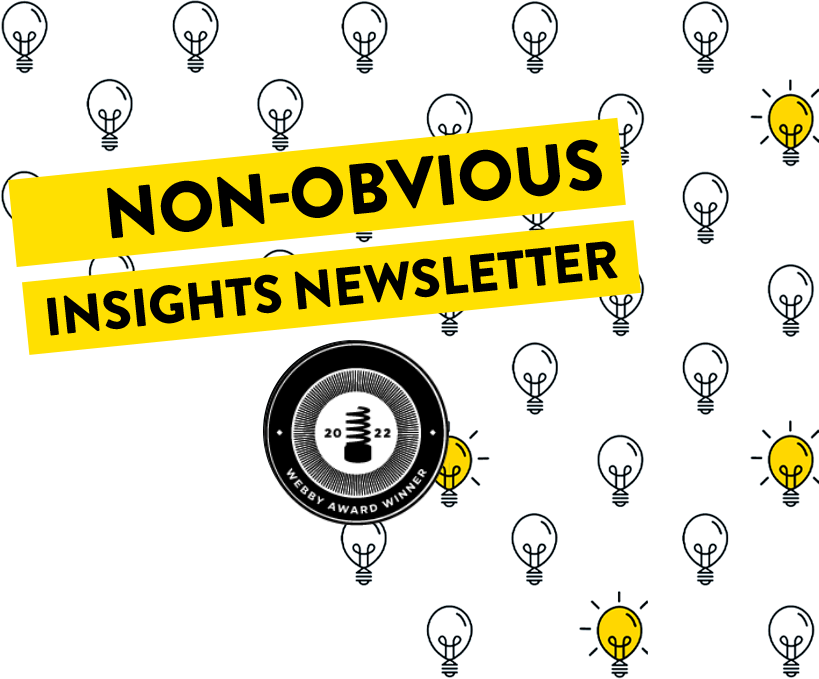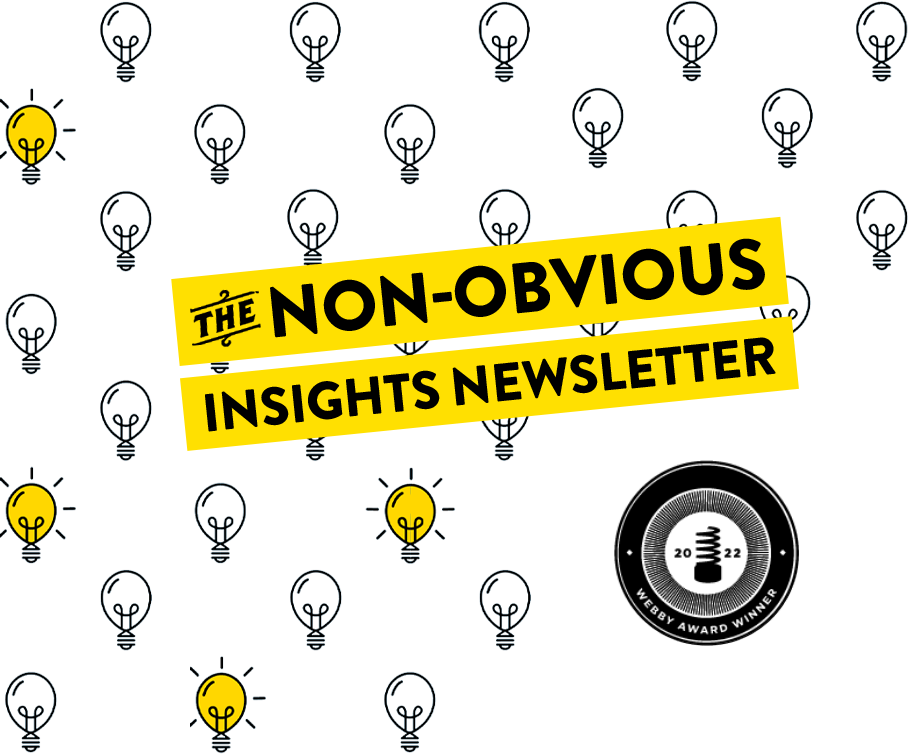Dear Fellow Non-Obvious Thinker,
After several weeks in Australia and New Zealand on a combination of holiday and work where I put the newsletter on hiatus (that’s the word that the celebrities use for a break, right?), I’m happy to be back at work this week and sharing another collection of non-obvious stories with you. I missed writing this and curating stories for you!
This week we will explore the insights behind the Cracker Barrel logo debacle, a trend around the intentional “dumbification” of technology, a restaurant that promises not to make money and the impending death of articulate criticism along with a question from me about whether it should matter for my writing or for any of us.
In the additional stories section, you’ll read about the sordid history of ice cream trucks, a powerful book revealing everything you will wish you didn’t know about how Facebook operated for the last decade and what really motivated the choices they made, for better or worse.
Enjoy the stories and stay curious!
This Month’s New Podcast Episodes
While I was away, Season 5 on the Non-Obvious Show continued! Here are a few of the latest podcast episodes from the show that you might have missed …
Of Course, the Cracker Barrel Logo “Backlash” Was Planned …
And It Worked Perfectly
Cracker Barrel announced they were ditching their old logo for a forgettable generic new one. The news got people to pay attention. Lots of them condemned the switch. Then predictably a few weeks later, they backtracked and brought back the old logo. I suspect that was always the plan. Here’s the one headline that should tell you everything you need to know about the ideal outcome of this strategy.
The Washington Post ran an article with this headline: “Cracker Barrel is trying to modernize. Bless its heart. Everyone’s mad at the old chain, but what is eating at one actually like in 2025?” And then the journalist goes on to visit, talks about his own nostalgia for the restaurant and even raves about their revamped menu. There is no way the restaurant brand could have pitched for such a rave review in a top-tier media publication which likely will get people to come and try it for themselves … but their temporary logo switch made it happen.
The brand is relevant again, and people are talking about it and visiting. The PR playbook for this strategy is simple:
- Identify a brand that is facing irrelevance.
- Change the logo to something boring and forgettable.
- Encourage the stories of “outrage” at the switch.
- Use the stories to demonstrate how much people care.
- Switch the logo back because you’re listening to your fans.
- Enjoy your newfound brand relevance.
This whole story strikes me as a great PR strategy executed perfectly. If anyone deserves credit (and a raise), it’s the PR team behind this whole thing.
How “Dumbification” May Be the Next Hot Technology Trend
What happens when all the good TVs that you can buy in the market are automatically programed as “smart” TVs, ready to connect to the Internet to stream shows from all platforms? For some people, it’s leading them to figure out how to turn that smart TV into a dumb one by removing all connectivity. This desire to go more basic when it comes to the technology we use isn’t new and it’s on the rise.
For anyone who has driven a rental car with overactive steering correction or endured constant unnecessary pop-up notifications about irrelevant things, the appeal of disabling “smart” tech is clear. It also explains why the sales of so-called dumb flip phones and cameras using physical film are increasing, as people are seeking ways to silence the constant interruptions of technology through a form of digital minimalism.
One cultural shift driving this is a growing recognition of the appeal of disconnected moments like going on a run without headphones or having a beautiful meal that goes unphotographed. And there are plenty of items we use in our lives that don’t really need to be internet-enabled. Like a toaster oven.
So as we head toward a future where more and more of the standard devices we use include wifi connectivity (whether it seems necessary or not), this trend of technology dumbification where people seek ways to modify smart technology to make it dumb again before using it will increase as well.
The Human Insight Behind a Restaurant That Promises Not to Make Any Money
A new restaurant in Manhattan called the Community Kitchen is doing a pilot test through November of a business model where people choose to pay what they can for a fine dining experience. The restaurant promises to use sustainable locally farmed ingredients, offer their workers a high wage and predictable hours, and a dining experience that rivals that of other establishments which might charge $100 a plate for a meal.
The dinner pricing is based on a fixed-menu meal on a sliding scale: $15 for lower income, $45 for middle incomes, and $125 for people who can afford it. While this pay-what-you-can model isn’t new, there’s an interesting insight behind how they have chosen to implement it:
“The concept of “pay what you can” isn’t new, though it has often meant uncomfortable exchanges at the register. “It turns into a humiliating negotiation for the payer and the payee,” Bittman says. By paying online in advance—or eventually through apps—diners won’t have to ask publicly for a lower price.”
It’s fascinating to think that the barrier for an idea like this to survive might be something as basic as embarrassment about what price you might reasonably be expected to pay. If this pay-ahead method can solve that, perhaps a concept like this could survive.
Given that it’s structured as a short-term test for a few months, and founder + NY Times columnist Mark Bittman has other ideas to support, it is an interesting experiment to watch … if you happen to be in NY, perhaps one to try for yourself too.
The Death of Articulate Criticism
No one cares what you hate on social media. Or at least they shouldn’t. But as the anonymity of the Internet offers up permission to people to be the worst versions of themselves, the exact opposite may be happening to professional critics of music, film and culture. In other words, they are getting nicer. In the New Yorker, this shift of how music critics “lost their edge“ is explored in an article this week:
“The idea that people’s tastes have a right not to be criticized is, of course, quite fatal to the idea of criticism itself, as many critics have noticed … film critics have had to contend not just with disgruntled directors and actors but with the fandoms that emerge, online, to defend their favorite characters or franchises. Often, I suspect, writers have decided to keep their most inflammatory views to themselves. “I think sometimes I can tell when a writer politely demurs, without saying as much,” one editor told me. “They’re just, like, The juice ain’t worth the squeeze.”
It now seems entirely likely that there will be a new generation that may never know the fun of reading an articulate takedown. I’m not talking about people whining about what they dislike online. There was once a place in the media for a knowledgeable writer who truly understood art or food or film to offer up a contrary argument. To point out that maybe that thing going viral isn’t as great as everyone says.
But doing that today puts a target on your back to be attacked online (and sometimes offline) for your dissent. So those critics are increasingly censoring themselves. Those 1-star reviews don’t get written and the contrarian perspectives are never shared. Instead, the only online criticism we ever see is the protestations of idiots written by those with vendettas or one-dimensional world views.
Is the solution for more writers to share more negative reviews? As many of you know, every week I offer up a book recommendation worth reading. Perhaps I should sometimes share a book that you definitely shouldn’t read. It just seems like a waste to spend time and attention on something that I don’t recommend. Honestly, I’m a bit conflicted now. What do you think? Would you want to read more negative reviews for entertainment purposes or is that a stretch?
The Non-Obvious Media Recommendation of the Week
Sydney Morning Herald
Inspired by my past month down under, I thought I’d include one of Australia’s biggest mainstream media publications, the Sydney Morning Herald, as my pick for the non-obvious media recommendation of the week. While not unusual for anyone living in Australia, this publication probably isn’t on your radar if you’re anywhere else in the world, but sometimes the perspective of looking at regional coverage with issues and topics unfamiliar to you can be a perfect way to break yourself out of your own media bubble. And sometimes the stories are quite non-obvious, like the one this week about the misnomer for the world’s most famous hat. Expanding your media diet starts with reading things from outside the country where you live and regional newspapers like this one are a great place to start.
The Non-Obvious Book of the Week
Careless People
If you thought, like I did, that many of the negative impacts that Facebook has had on our culture from failing to curb the spread of misinformation to offering evil people a platform was all about the money … this book will offer you a sobering reality check. Written by someone who was instrumental in that “growth at any cost” ethos that always defined Facebook, this is the ultimate highly readable tell-all memoir. From stories of crashing parties with Zuck to revealing stories of invitations from Sheryl Sandberg to share her bed on a private jet this book is a rare combination of shocking and oddly believable.
Ultimately, the most disturbing conclusion from the book is that the callous disregard for lives or countries destroyed by Facebook’s policies (or lack thereof) never came down to just money or greed. The leadership there simply didn’t care who suffered. More than anything, the book is a warning against handing the reins of the world to these “careless people” who lack the moral or ethical character to act in a way that will benefit anyone but themselves. We would all be better off if more of them were exposed as they are in this book. For these reasons, this is my pick for the Non-Obvious Book of the Week, and I highly recommend you not only read it but share it widely too.
About the Non-Obvious Book Selection of the Week:
Every week I share a new “non-obvious” book selection. Titles featured here may be new or classic books, but the date of publication doesn’t really matter. My goal is to elevate great reads that perhaps deserve a second look which you might have otherwise missed.
Even More Non-Obvious Stories …
Every week I always curate more stories than I’m able to explore in detail. Instead of skipping those stories, I started to share them in this section so you can skim the headlines and click on any that spark your interest:
- Nike Is Launching New SNKRS RESERVE System Allowing Fans to Pre-Order Sneakers Before They Go Live
- 99 Problems: The Ice Cream Truck’s Surprising History
- Are Bridges Near You Safe? This Innovative MRI-like Device Can Scan a Bridge and Assess Its Overall Health
- Undersound: The Secret Lives of Ponds and the Mysterious Musicality of the World
- This Cookbook Is Printed with Fading Ink to Mimic the Memory Loss of a Dementia Patient
- Netflix Wants Its Partners to Follow These Rules When Using Gen AI
How are these stories curated?
Every week I spend hours going through hundreds of stories in order to curate this email. Looking for a speaker to inspire your team to become non-obvious thinkers through a keynote or workshop?
Watch my new 2025 speaking reel on YouTube >>





